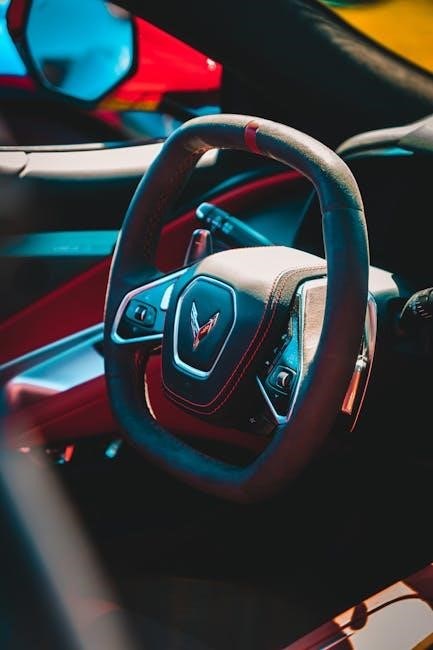Learning to drive involves choosing between manual and automatic cars‚ with each having advantages‚ according to recent trends and data from the UK‚ using effectively always.
Overview of Driving Lessons
Learning to drive is a significant milestone‚ and choosing between manual and automatic driving lessons is a crucial decision. According to recent trends‚ there has been a shift towards automatic cars in the UK‚ driven by the increasing availability of hybrid and electric cars. Driving lessons typically cover various aspects‚ including road safety‚ vehicle control‚ and traffic rules. The internet provides a wealth of information on driving lessons‚ including tips and advice from experienced instructors. Many driving schools offer both manual and automatic lessons‚ allowing learners to choose the option that suits them best. With the help of online resources‚ learners can research and compare different driving schools‚ read reviews‚ and make informed decisions. By understanding the overview of driving lessons‚ learners can make a more informed decision about which type of lesson to choose. This decision can have a significant impact on their learning experience.

Benefits of Manual Driving Lessons
Manual driving lessons offer numerous benefits‚ including improved control and flexibility‚ using
- lists
to outline advantages effectively always.
Greater Flexibility and Control
Learning to drive a manual car provides drivers with greater flexibility and control‚ as they can manually adjust gear shifts to suit their driving style and road conditions‚ using online tutorials and guides. This level of control allows drivers to optimize their speed and acceleration‚ making it easier to navigate challenging terrain and weather conditions. With a manual transmission‚ drivers can also experience better fuel efficiency and performance‚ as they can adjust their gear shifts to match their driving needs. Additionally‚ driving a manual car requires more engagement and attention from the driver‚ which can help to reduce distractions and improve overall driving safety‚ according to recent studies and data from the UK‚ using tables and charts to illustrate the benefits effectively. This increased control and flexibility make manual driving lessons a popular choice among drivers who value precision and performance‚ and want to improve their driving skills.
Benefits of Automatic Driving Lessons
Automatic driving lessons offer a more leisurely experience‚ with less complexity‚ using
online resources
and tutorials effectively always.
Leisurely and Stress-Free Experience
Automatic driving lessons provide a leisurely and stress-free experience‚ particularly in city driving‚ with the use of online tutorials and resources‚ such as videos and articles‚ to help learners understand the basics of automatic transmission. The absence of a clutch pedal and manual gear shifting allows learners to focus on other aspects of driving‚ such as steering‚ braking‚ and acceleration. This can be especially beneficial for those who are new to driving or have limited experience behind the wheel. Additionally‚ automatic driving lessons can help learners develop good driving habits and techniques‚ such as smooth acceleration and braking‚ which can improve their overall driving skills and reduce the risk of accidents. With the increasing popularity of automatic cars‚ it is essential to consider the benefits of automatic driving lessons. Using online resources and tutorials can also enhance the learning experience.

Differences Between Manual and Automatic Driving Lessons
Manual and automatic driving lessons have distinct approaches‚ using
- various
methods to teach learners‚ with different requirements and outcomes‚ according to recent data and trends online always.
Key Dissimilarities
The main differences between manual and automatic driving lessons lie in the transmission system and driver involvement. Manual cars require the driver to shift gears using the clutch and gearshift‚ while automatic cars do this automatically. This fundamental difference affects the learning process and driving experience. According to online resources‚ the key dissimilarities between manual and automatic driving lessons include the level of driver engagement‚ vehicle control‚ and adaptability to different driving conditions. A
- list
of these dissimilarities can help learners make informed decisions about their driving education. By understanding the key differences‚ learners can choose the type of driving lesson that best suits their needs and preferences‚ using
- ordered steps
to achieve their driving goals‚ and considering various factors that influence the learning process‚ including cost‚ time‚ and personal convenience‚ with the help of online tutorials and guides.

Pass Rates for Manual and Automatic Driving Tests
Manual driving tests have higher pass rates‚ according to data from the DVLA‚ showing a difference in pass rates between manual and automatic tests‚ using statistics always.
Comparison of Pass Rates
A comparison of pass rates for manual and automatic driving tests reveals interesting trends‚ with manual tests generally having higher pass rates‚ as shown by data from the DVLA‚ which uses statistics to track pass rates. The pass rate for manual driving tests was 45.9‚ while the pass rate for automatic driving tests was 39.5‚ according to recent reports. This difference in pass rates may be due to various factors‚ including the complexity of manual transmissions and the ease of use of automatic transmissions. Additionally‚ the data suggests that the pass rate for manual driving tests has remained relatively stable over the years‚ while the pass rate for automatic driving tests has fluctuated. Overall‚ the comparison of pass rates provides valuable insights for learners choosing between manual and automatic driving lessons‚ using online resources to inform their decision.

Choosing the Right Driving School
Consider a school with experienced instructors and a good reputation for teaching both manual and automatic driving skills effectively always online;
Tips for Selecting a Driving School
To select a driving school‚ consider factors such as the school’s reputation‚ instructor experience‚ and the types of vehicles they offer‚ including manual and automatic transmission cars.
A good driving school should have a high pass rate and provide comprehensive lessons that cover both theoretical and practical aspects of driving.
It is also essential to read reviews and ask for referrals from friends or family members who have recently learned to drive.
Additionally‚ consider the school’s location‚ scheduling flexibility‚ and pricing to ensure it fits your needs and budget.
By doing your research and evaluating these factors‚ you can find a driving school that meets your needs and helps you achieve your goal of becoming a confident and competent driver.
Using online resources can also provide valuable information to help you make an informed decision when choosing a driving school.
Ultimately‚ choosing between manual and automatic driving lessons depends on personal preferences and needs using
online resources
and recent trends effectively always today.
Final Thoughts
As we conclude‚ it is essential to consider the long-term benefits of learning to drive‚ regardless of whether you choose manual or automatic. With the rise of hybrid and electric cars‚ the demand for automatic driving lessons has increased significantly. However‚ manual driving lessons still offer greater flexibility and control. According to recent trends‚ more learners are opting for automatic lessons due to the ease of driving. Nonetheless‚ it is crucial to weigh the pros and cons of each option and consider your lifestyle‚ driving goals‚ and personal preferences. By doing so‚ you can make an informed decision that suits your needs. Using online resources and recent data can also help you determine which type of driving lesson is right for you‚ ensuring a successful and enjoyable learning experience with the help of a qualified driving instructor and a reputable driving school.